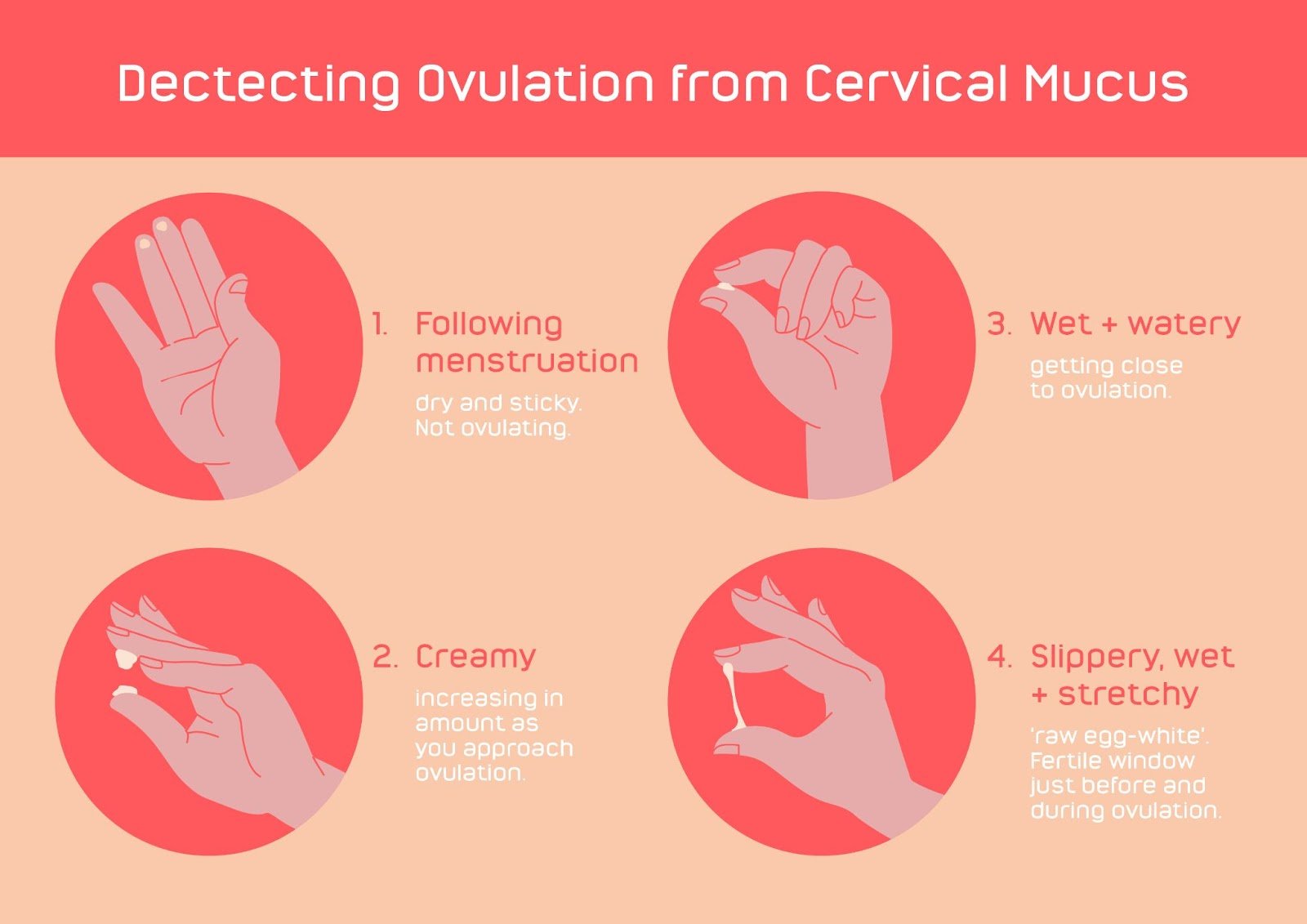Checking your cervical mucus can provide you with a wealth of information and help improve your chances of getting pregnant. Its colour and consistency and how much cervical mucus is produced change throughout your cycle.
By keeping track of these changes, you’ll learn to identify what your cervical mucus looks like just before ovulation - this is commonly known as fertile cervical mucus and is an excellent indicator that you are in your ‘fertile window’.
What is cervical mucus?
Cervical mucus is a secretion produced by your cervix, the entrance to your uterus from the vagina, also known as the ‘neck of the womb’. Hormones dictate the consistency, colour and quantity of your cervical mucus, which changes as your hormone levels change throughout your cycle.
Your vaginal discharge is mainly composed of cervical mucus and has three essential functions:
- It protects the uterus from the entrance of germs and dirt (and also sperm during certain days of your cycle).
- It keeps your vagina lubricated and clean (your discharge helps ‘wash away’ unwanted substances).
- And, just before and during ovulation, its consistency and composition change and become ‘sperm-friendly’ - helping sperm to stay alive and healthy and travel through the cervix to meet your egg.
- Knowing how to identify this fertile cervical mucus is essential when trying to conceive, as timing intercourse during these days increases your chances of getting pregnant.
Changes to cervical mucus
As we mentioned above, the changing levels of different hormones during your cycle result in changes to the colour and consistency of your cervical mucus and the cervix itself.
Here are the ovulation discharge stages that you can expect to experience:
1. Cervical mucus during menstruation
During menstruation - the little cervical mucus produced during your period is mixed with blood, so it is not identifiable.
2. Discharge after menstruation
Directly after menstruation, your discharge becomes minimal or is absent, and you have a few (usually 3-4) ‘dry days’. The chance of conception during these days is very low.
After this, your discharge slowly increases and becomes somewhat thick and a little sticky, varying in colour from white to cloudy or pale yellow. This change happens as your levels of oestrogen increase, and the follicle in one of your ovaries matures.
3. Vaginal discharge approaching ovulation
Vaginal discharge increases as you approach ovulation, becoming wetter and creamier, similar to a lotion.
4. Cervical mucus at ovulation
On the days immediately approaching ovulation and on ovulation day itself, your vaginal discharge will significantly increase in amount - usually becoming copious - and become transparent, stretchy and slippery, resembling a raw egg white discharge.
This is the perfect medium for sperm to survive and be transported through your reproductive system to meet your egg. This is known as fertile ovulation discharge or fertile mucus. These are your most fertile days.

5. Cervical mucus after ovulation
After ovulation, your oestrogen levels drop, and the hormone progesterone levels start to increase. This results in a decreased production of cervical mucus, causing your vaginal discharge to become drier, sticky, or absent. This lasts until your next period.
6. Early pregnancy discharge
If you have become pregnant, your cervical mucus may not dry up after ovulation.
For some women, this may indicate that they have conceived. However, the possible difference between your discharge before your period versus early pregnancy vaginal discharge is subtle and possibly only identifiable by women who are familiar with their own cycle and changes to their secretions.
7. Vaginal discharge during pregnancy
Once pregnant, your vaginal discharge will slowly increase, although this increase may not be noticeable until after week 8 of pregnancy. Vaginal discharge in pregnancy is known as leukorrhea. This is clear or ‘milky’ in colour, odourless and mild.
How to check your cervical mucus?

1. Following menstruation cervical mucus will be dry and sticky indicating that you are not ovulating. 2. When you are approaching ovulation, mucus will become creamy. 3. When you are getting close to ovulation, cervical mucus will be wet and watery. 4. Just before and during ovulation, discharge will be slippery, wet and stretchy just like a raw egg white, indicating you are in your fertile window.
Checking your cervical mucus is relatively straightforward. Observing the colour, consistency and amount of vaginal discharge on your underwear or when you wipe (before you pass urine) may be enough for some women.
Yet, when you are trying for a baby and you are charting, here’s how to check your cervical mucus for more accurate results:
- Start by washing your hands.
- Choose a position that feels easy and comfortable for you - this could be lying in bed, sitting on the toilet, standing up, squatting or with a leg up on a chair, side of the bed or edge of the bath.
- Insert a clean finger into your vagina. On days of heavier discharge, you may not need to go very far in, but on drier days, you’ll get a better sample if you reach closer to your cervix.
- Look at your finger and the colour and quality of your mucus. Rub the mucus between your fingers and pull it apart to see its consistency.
- Chart your findings using an ovulation planner.
Tips for checking cervical mucus
To ensure you get the most accurate ‘readings’ from your cervical mucus checks, follow these tips:
1. Check your cervical mucus after you’ve been for a ‘number 2’

After cleaning yourself (with water or wipes), wash your hands thoroughly, sit back on the toilet, or choose a comfortable position.
Feel the entrance to your vagina with a finger, or insert the tip inside. Opening your bowels will move your cervical mucus, making it easier to check.
2. Don’t check if you are sexually aroused until 1-2 days after sex
The secretions that you produce when you are in a state of arousal, as well as the presence of semen and lube in the vagina, could lead to confusion when checking your cervical mucus and give rise to inaccurate results.
3. Note that breastfeeding can alter your cervical mucus
When breastfeeding or expressing your breastmilk, your oestrogen hormone levels are low. This can cause irregular cycles, decreased cervical mucus and vaginal dryness, making checking your cervical mucus trickier.
4. Check any medication that you are taking

Certain drugs, such as antihistamines and even Clomid (a treatment for ovulatory failure), can reduce cervical mucus production. So, speak to your healthcare provider if you are on any regular medication to ensure your findings are not affected by what you are taking.
5. Non-touch ways to check your cervical mucus
Although it is probably most accurate to interpret the consistency of your cervical mucus by touching and feeling it, especially if this is a new thing for you, there are ways to check it, which do not involve putting a finger into your vagina or touching your vaginal discharge.
You can just look at your underwear or the toilet paper after you have passed urine. You can also focus on how wet or dry your vulva and vagina feel and make a note of that.
Other methods for tracking fertility
1. Basal Body Temperature

Basal body temperature (BBT) is the body temperature at rest. An increase in BBT is experienced once ovulation has occurred and progesterone is released. BBT can rise by around 0.5 degrees centigrade and stay raised until your period starts.
Tracking your BBT can help you understand possible patterns in your menstrual cycle and when you are most likely ovulating each month. Learn how to track your basal body temperature here.
2. Cervix position and consistency
The position and consistency (how it feels to the touch) of your cervix changes during your cycle, and checking it daily can help you understand your body, cervix and cycle better and inform you of where you are on your menstrual cycle.
If you want to try and feel your cervix, please remember that everyone’s uterus is positioned slightly differently, affecting where the cervix is felt.
3. Ovulation tests
Ovulation is triggered by a surge of LH in your system, which happens approximately 24-36 hours before the egg is released from one of your ovaries.
Therefore, if you use ovulation tests around ovulation, you should get a positive result as soon as the surge in LH levels has happened - this indicates that you are potentially on the most fertile days of your cycle.
Signs and symptoms
Mittelschmerz
Some women experience a dull ache on one side of their lower abdomen before, during or sometimes just after cervical mucus ovulation.
This is known as mittelschmerz, which means ‘middle pain’ in German.
Although the cause of this is uncertain, the possible irritation of nearby nerves by the fluid released with the egg is thought to play a part in it.
Mittelschmerz is not experienced by all women or at every cycle. Seeing as you could feel it during or even after ovulation, it may only be a helpful symptom to look out for in some women.
Feeling more sexual

When you are approaching and during your most fertile days, you may notice that you feel more sexual and, perhaps, sexier. This is a great indication to have sex when you are trying to conceive.
Breast tenderness & nipple pain
These symptoms usually appear after ovulation, so you can use these signs to confirm that ovulation has taken place.
Read more about the signs and symptoms of ovulation here.
Key Takeaway
Planning and preparing to become pregnant is associated with better outcomes and improved health for women, children and families. Learning to check your cervical mucus ovulation and interpret your findings is an essential tool that can give you valuable information to maximise your chances of conceiving.




















